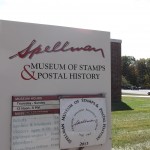 Sponsored by Smithsonian magazine, today was Museum Day Live! Insofar as I’m a member of the Smithsonian, I had previously downloaded a free ticket to visit one of the museums in this area: I chose the Spellman Museum of Stamps and Postal History, located on the grounds of Regis College in Weston.
Sponsored by Smithsonian magazine, today was Museum Day Live! Insofar as I’m a member of the Smithsonian, I had previously downloaded a free ticket to visit one of the museums in this area: I chose the Spellman Museum of Stamps and Postal History, located on the grounds of Regis College in Weston.
I left my house a bit after 11 am and arrived at the museum a little over an hour later. The museum opens at noon, so I was probably the first to arrive. The docent (or maybe he was the curator) treated me a quick personalized tour, then left me to browse the exhibits at my leisure.
The “Spellman” in the museum’s name is Cardinal Francis Spellman, born in 1889 in Whitman, Massachusetts. The sixth archbishop of New York from 1939 to 1967, he was also an enthusiastic philatelist, and it was his personal collection that became the basis of the museum, which was founded in 1960. Over the years, the collection has grown considerably and now contains over two million philatelic items, ranging from postage stamps, to postal history, to artifacts of communications by postal services.
The museum is one room on the building’s first floor, and although it looks more like a large classroom, the exhibits are displayed well and are easy to peruse. They are grouped somewhat thematically, though the visitor isn’t guided from one to the next in a linear fashion. So my review below is in alphabetical order by topic, though I chose the categories myself (the photos were taken randomly).
Animals. I love animals, and apparently so do people who create and use stamps, because they have been portrayed on many stamps. And think of the “owl posts” from the Harry Potter books: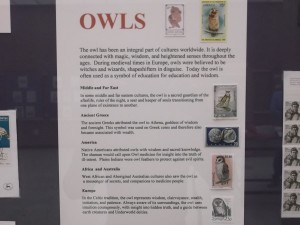 Balloons, pigeons, submarines. Mail has also been carried by balloons, submarines, and carrier pigeons. The pigeons were particuarly effective during the 1870-1871 siege of Paris, although delivery was not guaranteed. Here’s a drawing depicting how small tubes were attached to the pigeon’s feet:
Balloons, pigeons, submarines. Mail has also been carried by balloons, submarines, and carrier pigeons. The pigeons were particuarly effective during the 1870-1871 siege of Paris, although delivery was not guaranteed. Here’s a drawing depicting how small tubes were attached to the pigeon’s feet:
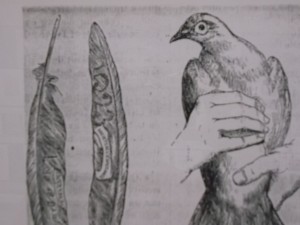 Boston Post Road. The road had one terminus in Boston and the other in Battery Park in New York City. There were actually three routes: the Upper with a length of 250 miles, the Middle with a length of 225 miles, and the Lower, running 270 miles. Mail was first carried by horses, not coaches. Until the advent of the telegraph in 1835 and the telephone in 1876, mail was the only means of communication between distant locales. The importance of such routes as the Boston Post Road, which we in Central Mass know as Route 20, cannot be overstated. The arrival of the mail brought news of family, promoted business ventures, and sparked communal discussions of national events.
Boston Post Road. The road had one terminus in Boston and the other in Battery Park in New York City. There were actually three routes: the Upper with a length of 250 miles, the Middle with a length of 225 miles, and the Lower, running 270 miles. Mail was first carried by horses, not coaches. Until the advent of the telegraph in 1835 and the telephone in 1876, mail was the only means of communication between distant locales. The importance of such routes as the Boston Post Road, which we in Central Mass know as Route 20, cannot be overstated. The arrival of the mail brought news of family, promoted business ventures, and sparked communal discussions of national events.
 Civil War. Stamps were issued by both the Union and the Confederacy; Confederate stamps pictured such people as Jefferson Davis. Mail going from North to South was exchanged at City Point, Virginia, whereas mail going from South to North was exchanged at Fortress Monroe. Here’s a photo of the Postmaster General of the Confederate States, who was captured by the Union:
Civil War. Stamps were issued by both the Union and the Confederacy; Confederate stamps pictured such people as Jefferson Davis. Mail going from North to South was exchanged at City Point, Virginia, whereas mail going from South to North was exchanged at Fortress Monroe. Here’s a photo of the Postmaster General of the Confederate States, who was captured by the Union:
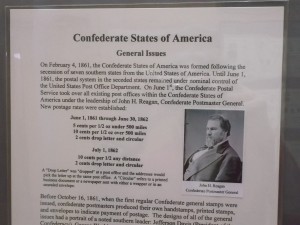 Columbian Quincentenary. The 500th anniversary of Columbus’ arrival in the New World, which occurred in 1992, was the occasion for issuing many commemorative stamps.
Columbian Quincentenary. The 500th anniversary of Columbus’ arrival in the New World, which occurred in 1992, was the occasion for issuing many commemorative stamps.
Games and Stamp Cases. This part of the collection includes games about stamps and postal services, as well as examples of cases to hold stamps.
Hispanic Heritage Month. We’re in the middle of this year’s celebration, which runs from September 15 to October 15; the museum created an exhibit of stamps that honor the achievements of Hispanic Americans.
Rarities. Stamps are considered rare for various reasons; sometimes this is due to a printing mistake. Naturally, when a mistake is discovered, the print run ends, and the limited number issued makes each stamp a collector’s item. This museum owns a few of these. One of them, the wrong person depicted in the “Legends of the West” series, is fairly recent and dates from 1994. Another rare stamp is the “Double Geneva” issued in Switzerland; this one dates from the mid-nineteenth century. Stamps as we know them date from the nineteenth century. First issued by the UK in 1840 (the first American stamp was issued in 1857), the British “Penny Black” featured Queen Victoria . Because so many were produced, these stamps are not rare, but they are special, which is why I’ve included them in this category:
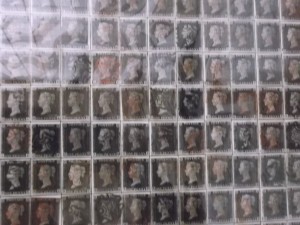 Steinway Collection. Grandson of the founder of Steinway Pianos, Theodore Steinway was an ardent philatelist. His collection includes postage stamps from all over the world which depict music, musical instruments, musicians, composers, and the like. I was fascinated by envelopes showing postmarks (cancellations) that were parts of musical scores!
Steinway Collection. Grandson of the founder of Steinway Pianos, Theodore Steinway was an ardent philatelist. His collection includes postage stamps from all over the world which depict music, musical instruments, musicians, composers, and the like. I was fascinated by envelopes showing postmarks (cancellations) that were parts of musical scores!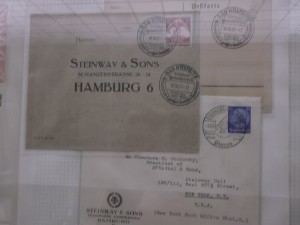 Transportation. Considering that stamps are instruments for “moving stuff around,” many stamps depicting modes of transport have been issued over the years by almost all countries. These modes range from walking and camels to ships and planes. Here are a few depicting airplanes:
Transportation. Considering that stamps are instruments for “moving stuff around,” many stamps depicting modes of transport have been issued over the years by almost all countries. These modes range from walking and camels to ships and planes. Here are a few depicting airplanes:
 War mail. The censored mail documents, displaced persons correspondence, and the “Postal History of the Holocaust” exhibit were horrifying and heartbreaking. The museum also put together a fascinating exhibit titled “The Post Office Goes to War” which describes the use of microphotography and the airgraph service. It was called V-Mail and was used extensively from 1941-1945. Here’s an advertisement:
War mail. The censored mail documents, displaced persons correspondence, and the “Postal History of the Holocaust” exhibit were horrifying and heartbreaking. The museum also put together a fascinating exhibit titled “The Post Office Goes to War” which describes the use of microphotography and the airgraph service. It was called V-Mail and was used extensively from 1941-1945. Here’s an advertisement:
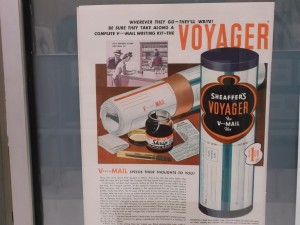 Zeppelins. Odd as it might sound, “Zeppelin Aerophilately” is a specialized field of stamp collecting which focuses on mail sent by zeppelin. The Graf Zeppelin, or LZ-127, the famous German airship, made regularly scheduled flights between 1928 and 1937 and of course carried mail.
Zeppelins. Odd as it might sound, “Zeppelin Aerophilately” is a specialized field of stamp collecting which focuses on mail sent by zeppelin. The Graf Zeppelin, or LZ-127, the famous German airship, made regularly scheduled flights between 1928 and 1937 and of course carried mail.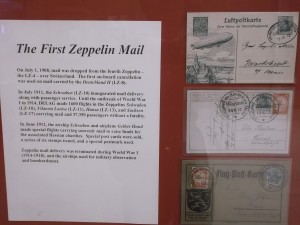 I’m sorry for the poor quality of the photographs — I’m not keen on photography to begin with, and the lighting is kept low in the museum for preservation reasons.
I’m sorry for the poor quality of the photographs — I’m not keen on photography to begin with, and the lighting is kept low in the museum for preservation reasons.
The museum is open for limited hours during the week, but if you are at all interested in history or geography or communications, it’s well worth a visit.





